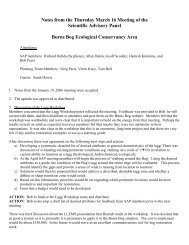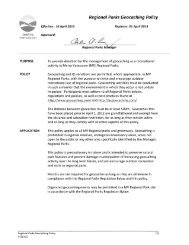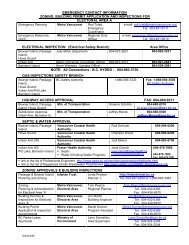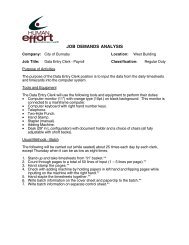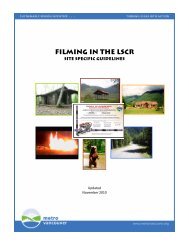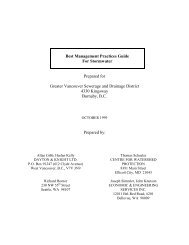Chlorine Monitoring and Dechlorination Techniques Handbook
Chlorine Monitoring and Dechlorination Techniques Handbook
Chlorine Monitoring and Dechlorination Techniques Handbook
You also want an ePaper? Increase the reach of your titles
YUMPU automatically turns print PDFs into web optimized ePapers that Google loves.
<strong>Chlorine</strong> <strong>Monitoring</strong> <strong>and</strong> Dechlorinating <strong>Techniques</strong> H<strong>and</strong>book<br />
Since the municipal water system is used for more than supplying water for human<br />
consumption, for instance cooling water, the potential exists for this water to be discharged<br />
directly to the environment. If chlorinated water reaches an aquatic system, it has the<br />
potential to kill fish <strong>and</strong> other aquatic organisms because of the chlorine concentration. One<br />
mode of action is likely through damaging the gills, thus preventing the fish from breathing.<br />
Therefore, in many instances, it will be necessary to dechlorinate the water in order to make<br />
it safe for discharge to the environment. This h<strong>and</strong>book provides guidance <strong>and</strong> recommended<br />
dechlorination techniques as well as methods for monitoring chlorine levels in municipal<br />
water.<br />
1.2 Chemical Reactions<br />
<strong>Chlorine</strong> gas hydrolyzes in water almost completely to form hypochlorous acid, under the<br />
following reaction:<br />
Cl2 + 2H2O HOCl + H + + Cl -<br />
The hydrogen ions released in the reaction cause a reduction in pH. The pH is important in<br />
determining to what extent the hypochlorous acid (HOCl) can dissociate to produce<br />
hypochlorite (OCl - ) ions:<br />
HOCl<br />
H + + OCl -<br />
The hypochlorous acid form of chlorine is the prime disinfecting agent. The term free<br />
available chlorine or free chlorine refers to both the HOCL <strong>and</strong> OCl - portions present in<br />
the water. The ratio between HOCL <strong>and</strong> OCl - is primarily a function of pH. For example, 96<br />
percent of the free available chlorine is present as HOCl at pH 6, 75 percent at pH 7 <strong>and</strong> only<br />
3 percent at pH 9.<br />
If chlorine is added to water which contains ammonia, the ammonia will combine with the<br />
chlorine to form chloramines. The portion of chlorine that is present as chloramines as well<br />
as chlorine combined with other specific nitrogenous compounds 1 is referred to as combined<br />
available chlorine . Total residual chlorine (or residual chlorine as used in this h<strong>and</strong>book)<br />
is the sum of the free available chlorine plus the combined available chlorine . This<br />
includes all the forms of chlorine which are able to act as an oxidant <strong>and</strong> are hazardous to<br />
aquatic life.<br />
1 for example, N-chloramides<br />
Page 2



